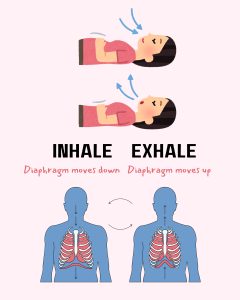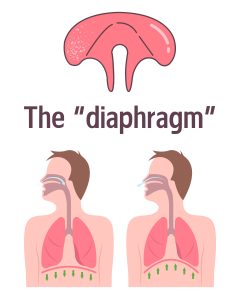20
Diaphragmatic Breathing

Take a deep breath.
Did you breathe with your chest or your belly? Take another deep breath and focus on filling your belly with air.
As you inhale, your diaphragm lowers. The diaphragm is a muscle that separates the lungs from the abdominal cavity. When you breathe in, your belly expands.
When you exhale, your diaphragm moves back out and your belly retracts.
Your pelvic floor plays a significant role in breathing. When you inhale, your pelvic floor relaxes, and when you exhale, it contracts.
Muscles used in breathing:

Diaphragm
The diaphragm plays a crucial role in the respiratory system, serving as the primary muscle for breathing. It is a large, dome-shaped structure situated at the base of the lungs. When you inhale, the diaphragm contracts and moves downward, creating a vacuum that allows air to flow into the lungs. This action is essential for efficient gas exchange, as it helps to fill the lungs with oxygen.
Abdominal muscles
Abdominal muscles contribute to the breathing process, particularly during exhalation. By contracting, they assist in pushing the diaphragm back up, which helps to expel air from the lungs more effectively. This coordinated effort between the diaphragm and the abdominal muscles ensures that our bodies maintain an adequate supply of oxygen and remove carbon dioxide efficiently. Understanding how these muscles work together highlights the importance of proper breathing techniques for overall health and respiratory function.
Why use diaphragmatic breathing?
In diaphragmatic breathing, you engage your diaphragm purposefully, drawing deep, revitalizing breaths. Unlike the shallow, instinctive breaths of everyday life, this technique unlocks the true potential of your lungs. With each inhalation, you fill your lungs to their fullest capacity, drawing in a wave of oxygen that energizes every cell in your body. This breathing method not only enhances lung efficiency but also cultivates a profound sense of calmness and well-being.
- Strengthen the capacity of the diaphragm
- Reduce the effort associated with respiration by moderating the respiratory rate
- Optimize oxygen utilization
- Minimize the effort and energy expended during the breathing process.
Benefits of diaphragmatic breathing
- Lower blood pressure
- Lower heart rate
- Promote sense of relaxation
- Increase postural recognition
- Increase muscle function
- Increase core muscle strength
- Increase oxygen in blood cells
- Improve transfer of gas from lungs
- Engage parasympathetic nervous system
Explore
References:
Cleveland Clinic. (2022, March 30). Diaphragmatic breathing.. https://my.clevelandclinic.org/health/articles/9445-diaphragmatic-breathing
Hinge Health. (2024, June 3). Breathing exercises for pelvic floor muscle relaxation and flexibility. https://www.hingehealth.com/resources/articles/diaphragmatic-breathing-pelvic-health/
Hinge Health. (2024, July 31). How to do diaphragmatic breathing: A hinge health guide. https://www.hingehealth.com/resources/articles/diaphragmatic-breathing/
Physiopedia. (2023, April 29). Diaphragmatic breathing exercises. https://www.physio-pedia.com/Diaphragmatic_Breathing_Exercises
Media Attributions
- Inhale
